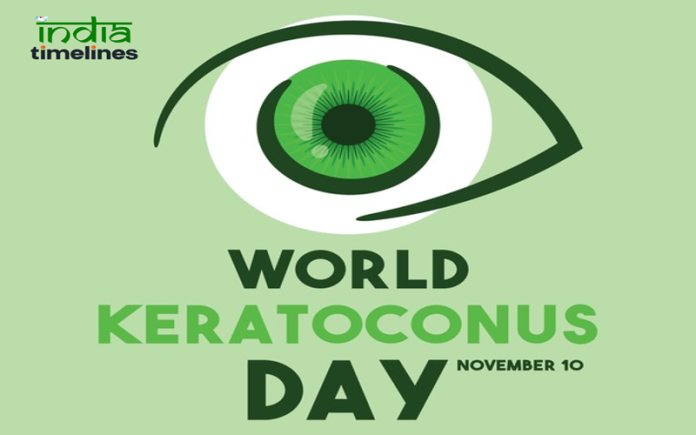
Keratoconus is a relatively lesser-known yet impactful eye disorder that affects millions of people worldwide. World Keratoconus Day, celebrated on November 10th, provides an opportunity to raise awareness about the condition, share information, and support those living with keratoconus. While the day may seem insignificant to some, it serves as an important reminder of the challenges faced by individuals with this progressive eye disease. This article aims to shed light on the importance of World Keratoconus Day, the science behind keratoconus, its symptoms, causes, treatments, and the role of early detection in improving quality of life.
What is Keratoconus?
Keratoconus is a degenerative eye disorder that causes the cornea, the transparent, dome-shaped front part of the eye, to thin out and gradually bulge into a cone shape. This distortion leads to blurred vision, difficulty focusing, and increased sensitivity to light. Unlike many other eye conditions, keratoconus often affects both eyes, though one eye may be more severely impacted than the other.
The cornea is responsible for refracting light and helping the eye focus. In a healthy eye, the cornea maintains a smooth, regular shape that ensures clear vision. However, in individuals with keratoconus, the cornea weakens and becomes irregular, leading to vision problems that can be severe if left untreated.
Symptoms of Keratoconus
Keratoconus symptoms typically begin during adolescence or early adulthood, though they can appear at any age. The condition often progresses over the years, making early diagnosis crucial for effective management. Common symptoms include:
- Blurred Vision: The most common and noticeable symptom is distorted or blurry vision. This can make it difficult to perform everyday tasks such as reading, driving, or watching television.
- Frequent Changes in Prescription: Individuals with keratoconus often notice that their eyeglass or contact lens prescription needs frequent adjustments. Despite these changes, vision may still remain suboptimal.
- Light Sensitivity: People with keratoconus may experience increased sensitivity to light (photophobia), particularly in bright environments. Glare and halos around lights at night are also common complaints.
- Double Vision in One Eye: Some individuals report seeing multiple images of the same object, even with one eye covered. This is a result of the corneal irregularity caused by keratoconus.
- Astigmatism and Myopia: As the cornea becomes more irregularly shaped, astigmatism (distorted or blurred vision at all distances) and myopia (nearsightedness) often develop or worsen.
Causes and Risk Factors
The exact cause of keratoconus is still not fully understood. However, researchers believe it is likely the result of a combination of genetic, environmental, and biochemical factors. Some potential causes and risk factors include:
- Genetics: There is evidence to suggest that keratoconus may have a genetic component. It is more likely to occur in individuals with a family history of the disorder. However, keratoconus does not follow a straightforward inheritance pattern.
- Chronic Eye Rubbing: Vigorous eye rubbing is thought to be a contributing factor to the development of keratoconus. This is particularly common in people with allergies or conditions that cause chronic eye irritation.
- Oxidative Stress: Some researchers propose that keratoconus may be linked to oxidative stress, where an imbalance between free radicals and antioxidants in the cornea leads to tissue damage and weakening.
- Underlying Medical Conditions: Certain medical conditions, such as Down syndrome, Ehlers-Danlos syndrome, and Marfan syndrome, have been associated with an increased risk of keratoconus. Additionally, people with asthma, hay fever, and eczema may be at higher risk.
- Hormonal Changes: Hormonal changes, particularly during adolescence and pregnancy, may play a role in the development and progression of keratoconus. The condition often begins during puberty, and some women experience a worsening of symptoms during pregnancy.
Diagnosis of Keratoconus
Early diagnosis of keratoconus is critical to prevent severe vision impairment. Ophthalmologists and optometrists use a variety of tests and tools to diagnose keratoconus, including:
- Corneal Topography: This non-invasive imaging technique maps the curvature of the cornea, allowing doctors to detect any irregularities or thinning that may indicate keratoconus. It is one of the most effective ways to diagnose the condition in its early stages.
- Slit-Lamp Examination: A slit-lamp microscope allows doctors to examine the cornea and detect signs of keratoconus, such as corneal thinning, scarring, or stress lines known as Vogt’s striae.
- Pachymetry: This test measures the thickness of the cornea. Keratoconus causes the cornea to become thinner over time, making pachymetry an essential tool for diagnosing and monitoring the progression of the disease.
- Keratometry: A keratometer measures the curvature of the cornea by analyzing how light reflects off its surface. Abnormally steep curvatures may indicate keratoconus.
Treatment Options for Keratoconus
The treatment for keratoconus depends on the severity of the condition and how far it has progressed. While there is no cure for keratoconus, various treatments are available to manage symptoms and prevent further progression. Early intervention is key to preserving vision and quality of life.
1. Eyeglasses and Contact Lenses
In the early stages of keratoconus, eyeglasses or soft contact lenses may be sufficient to correct vision problems. However, as the condition progresses, more specialized contact lenses may be necessary, such as:
- Rigid Gas Permeable (RGP) Lenses: These hard lenses provide better vision correction for individuals with keratoconus by sitting on the cornea’s surface and providing a smooth, regular shape for light to focus through.
- Scleral Lenses: These larger contact lenses rest on the sclera (the white part of the eye) and vault over the irregular cornea, providing a more stable and comfortable fit for people with advanced keratoconus.
2. Corneal Cross-Linking
Corneal cross-linking is a minimally invasive procedure designed to halt the progression of keratoconus. During the procedure, riboflavin (vitamin B2) drops are applied to the cornea, followed by exposure to ultraviolet (UV) light. This process strengthens the collagen fibers in the cornea, preventing further thinning and bulging.
Corneal cross-linking does not cure keratoconus or restore lost vision, but it can stop the condition from worsening. The earlier cross-linking is performed, the better the chances of preserving vision.
3. Intacs
Intacs are small, crescent-shaped inserts made of plastic that are surgically implanted into the cornea to help flatten and reshape it. This procedure is typically recommended for individuals with moderate keratoconus who are no longer able to achieve clear vision with glasses or contact lenses.
Intacs can improve vision and make it easier to wear contact lenses, but they do not halt the progression of keratoconus. Corneal cross-linking may be recommended in conjunction with Intacs to stabilize the cornea.
4. Corneal Transplantation
In severe cases of keratoconus, when other treatments are no longer effective, a corneal transplant (keratoplasty) may be necessary. During this procedure, the damaged cornea is replaced with a healthy donor cornea. There are two types of corneal transplants:
- Penetrating Keratoplasty (PK): The entire thickness of the cornea is replaced with a donor cornea.
- Deep Anterior Lamellar Keratoplasty (DALK): Only the front layers of the cornea are replaced, leaving the innermost layer intact. This procedure reduces the risk of rejection compared to full-thickness transplants.
Corneal transplantation is highly successful, with most patients experiencing significant improvements in vision. However, as with any surgery, there are risks involved, and recovery can take several months.
The Importance of World Keratoconus Day
World Keratoconus Day, observed annually on November 10th, plays a vital role in increasing public awareness of keratoconus, a condition that often goes undiagnosed in its early stages. Many people with mild symptoms may not realize they have keratoconus until the condition has progressed, leading to avoidable vision loss.
By dedicating a day to keratoconus, the global eye health community aims to:
- Educate the Public: Increased awareness of keratoconus can lead to earlier diagnosis and intervention, preventing severe vision loss for many individuals. Public campaigns, social media initiatives, and educational events help inform people about the symptoms, risk factors, and available treatments.
- Support Those Affected: World Keratoconus Day provides a platform for individuals with keratoconus to share their experiences, connect with others who have the condition, and access resources for managing their vision health.
- Encourage Research: More awareness of keratoconus can lead to increased funding for research into new treatments, diagnostic tools, and potentially a cure for the condition. Researchers continue to explore the genetic and environmental factors involved in keratoconus, as well as innovative treatment options.
India Time Lines
Living with Keratoconus: Patient Stories
Hearing from individuals living with keratoconus can provide valuable insight into the challenges of managing the condition and the importance of early detection and treatment. Many people with keratoconus lead full, active lives despite their vision impairment



































